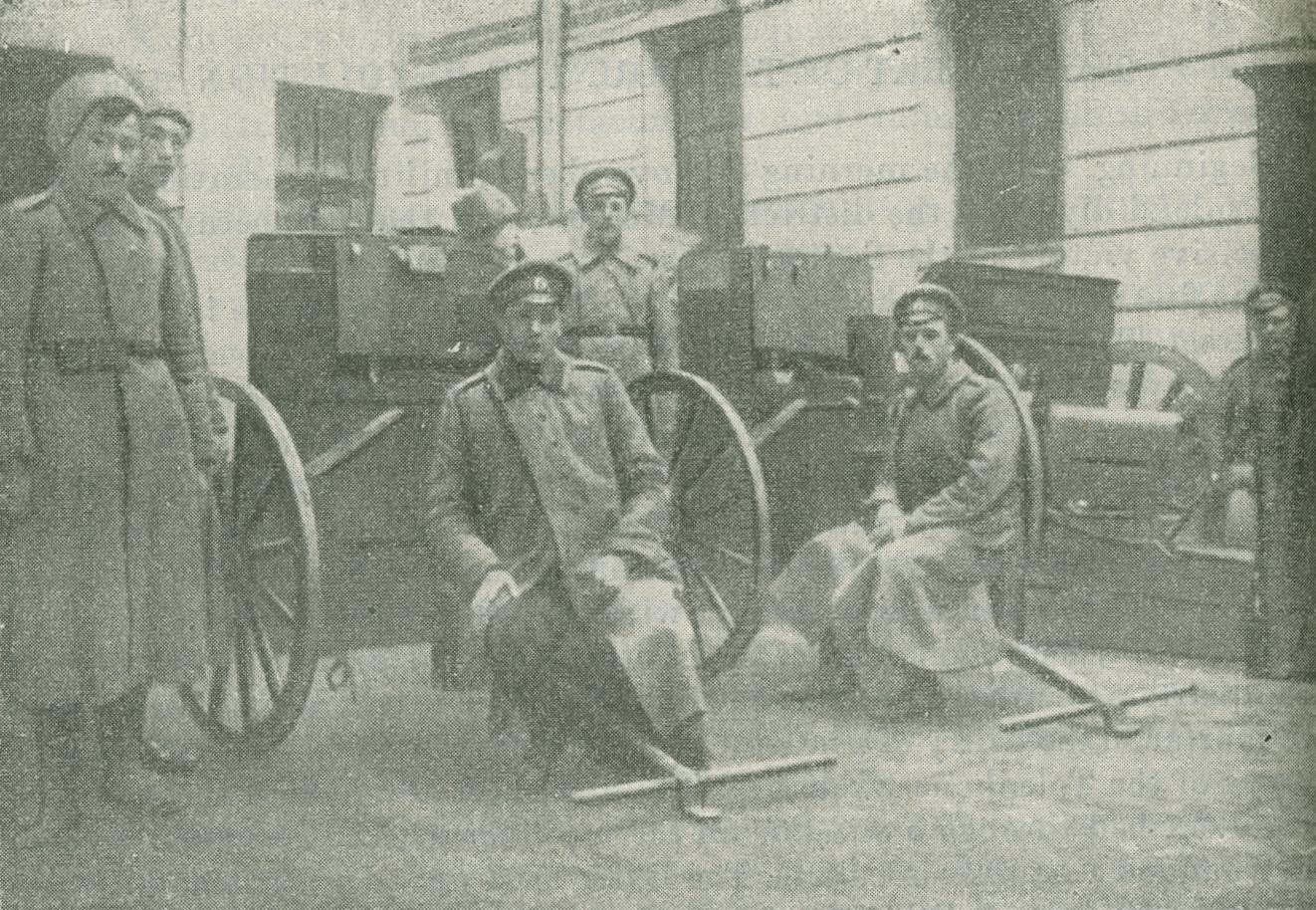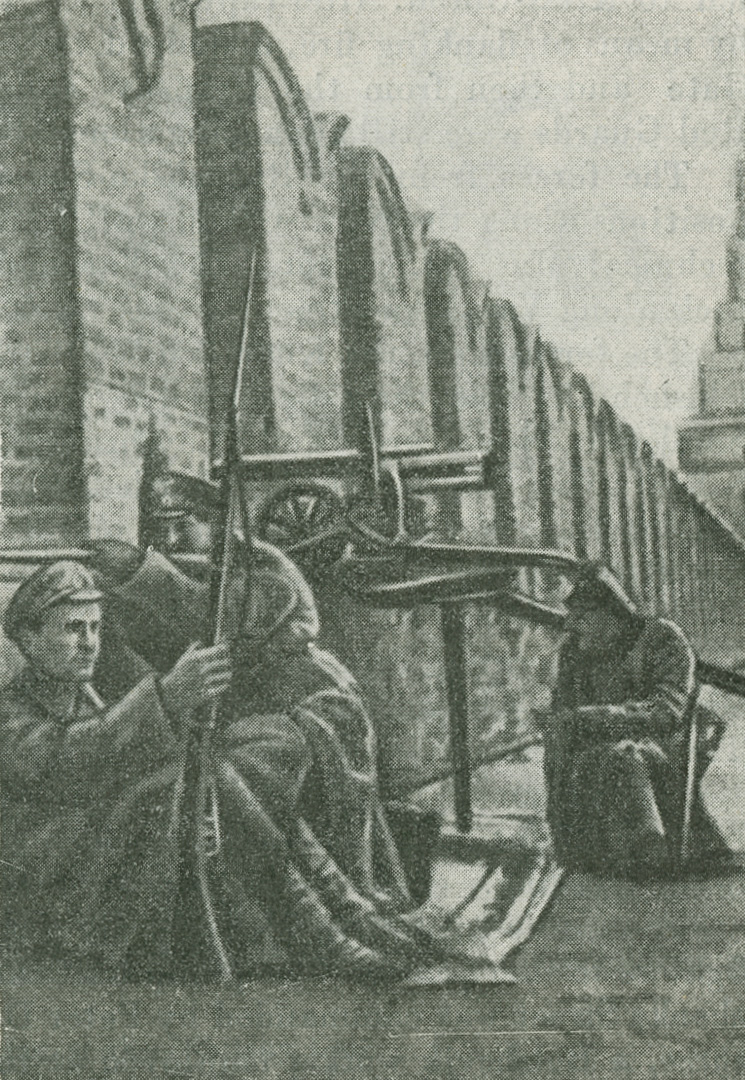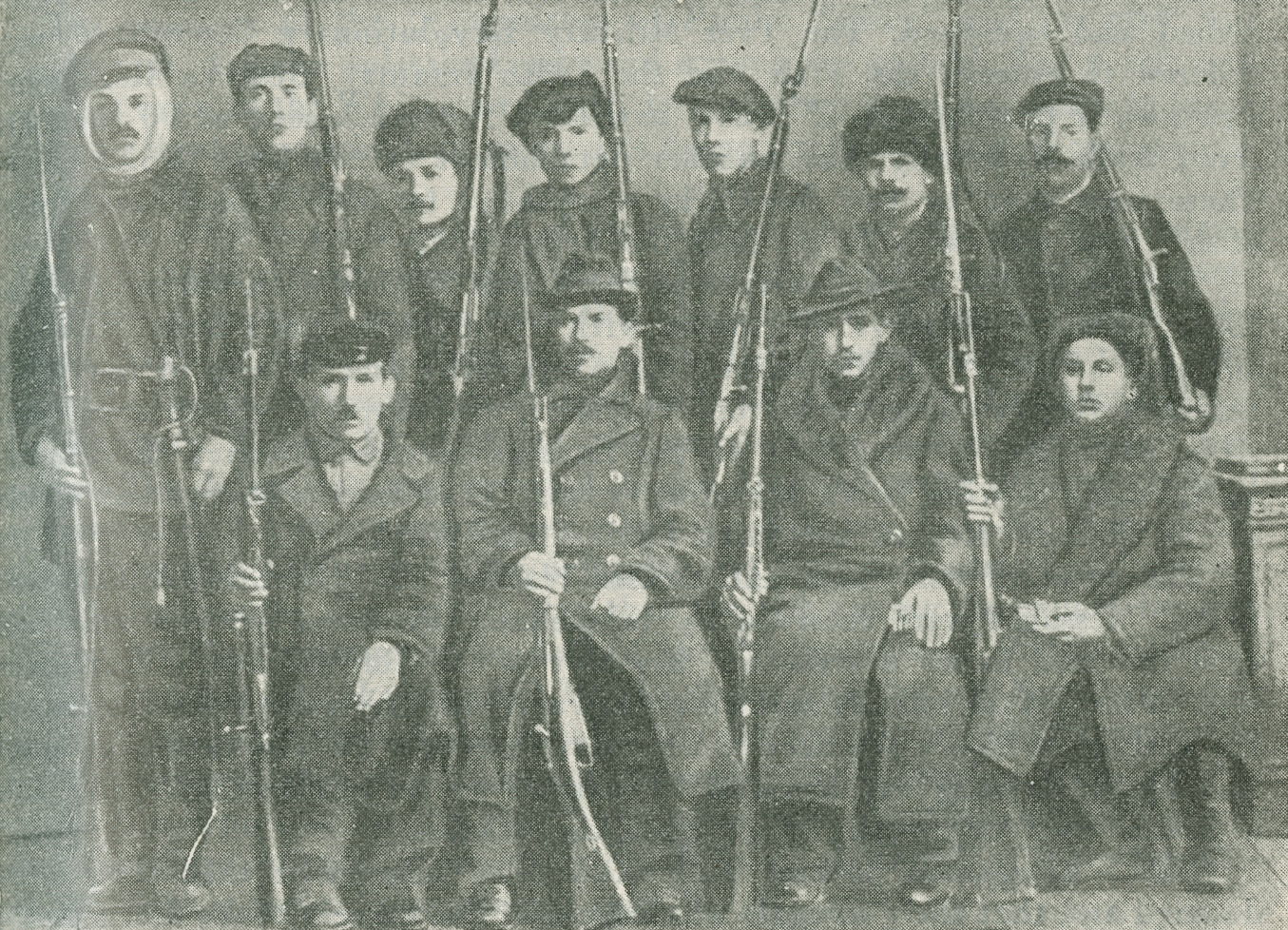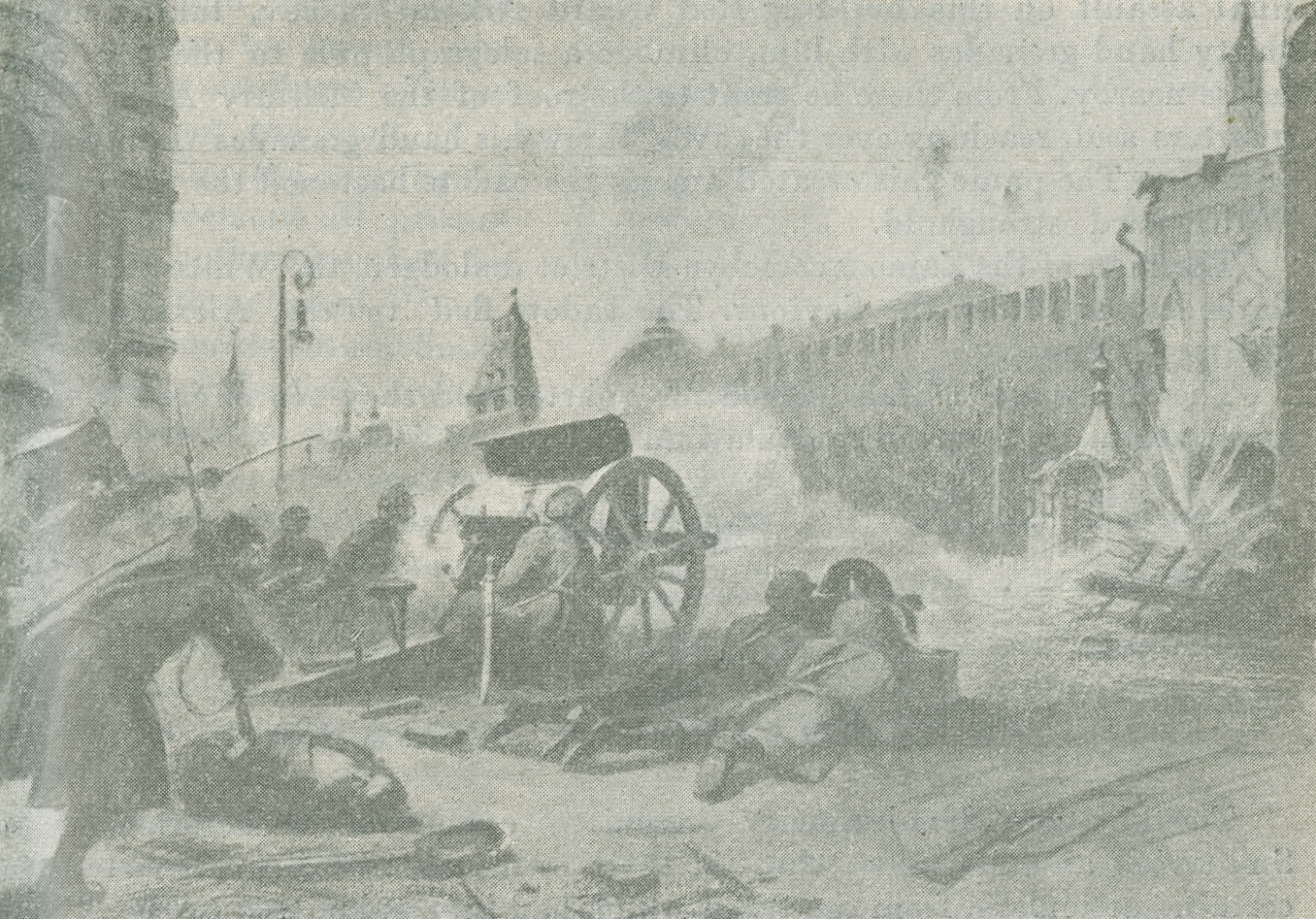
Beginning with the morning of November 1, military operations developed splendidly in all the districts of Moscow, and that day became the day of decisive victory of the Soviet forces.
The first success was the capture of the Telephone Exchange in Milyutinsky Street. This tall, fortress-like building, with few windows, was well adapted for defence. The Whites had blocked the entrances with logs and dismantled iron gates and had barricaded the street. They maintained such a heavy machine-gun and rifle fire that it was impossible to approach the building. Well supplied with food and ammunition, they were in a position to withstand a siege of many days. Inside the building the telephone staff continued with their work, maintaining contact with the Whiteguard centre.
Usiyevich, the commander of the besieging forces, sent a request to Staff Headquarters for artillery and at dawn, on November 1, the Red Guards planted a mortar in the belfry of a nearby church and began to bombard the upper storeys of the Telephone Exchange. The first shell dropped on the roof; the second crashed through a window on the top floor where it wrecked a room and wounded a number of cadets. The latter then waved a white flag. Usiyevich demanded unconditional surrender, guaranteeing their personal safety. Ten minutes later the cadets and officers began to file out of the building and to stack their arms.
At 5 a.m., on November 1, the Staff of the Military Revolutionary Committee sent three detachments of fifty men each to Theatre Square, one to be posted near the Maly Theatre, another near the Grand Theatre, and the third near the Hotel Central in Petrovka Street. A three-inch gun was planted near the Grand Theatre to bombard the City Duma. At the same time the detachment in Okhotny Ryad, after receiving reinforcements, captured the Hotel Continental. This made it possible to place a second gun in Teatralny Proyezd and to bombard the Hotel Metropole. Red units appeared almost at the walls of the Kremlin. The detachments of the Zamoskvorechye District, on the opposite side of the Moscow River, kept the battlements of the Kremlin walls under constant machine-gun and rifle fire, but the thick walls afforded the cadets excellent protection.
An important role on the Staff of the Zamoskvorechye District was played by Professor P. K. Sternberg, lecturer on astronomy at the Moscow University, a scientist of European repute, who had joined the Bolsheviks as early as 1905. On his appointment as a member of the Zamoskvorechye District Military Revolutionary Committee, Professor Sternberg set to work with the greatest energy. Exceedingly kind-hearted, he was greatly moved by the sufferings of the wounded. So distinctly a civilian, with all the characteristics of the old style intellectual, he caused considerable astonishment when he appeared in the firing line. But a brave revolutionary heart beat beneath this mild exterior. Prof. Sternberg displayed remarkable firmness and determination, and the example he set inspired the Red Guards to perform feats of bravery and self-sacrifice.

The problem of how to capture the Kremlin was the subject of repeated discussion at Staff Headquarters. A worker employed at the Michelson Plant suggested that entrance to the Kremlin be gained by means of the Neglinka, a small tributary of the Moscow River. This rivulet flows through an underground tube with an outlet near the Kremlin. The idea was that men should row up the tube at night in boats, enter the Kremlin that way and take it by storm. Finally it was decided to bombard the Kremlin.
That same morning a conference of district staffs was held at the Headquarters of the Moscow Military Revolutionary Committee. The conference demanded that all the technical means available, even aerial bombing, should be used against the Whites, and that decisive operations should be commenced against the cadets in the Kremlin and the Alexandrovsky Military School. The Military Revolutionary Committee accepted this plan of action, but banned aerial bombing and the bombardment of the City Duma. The 7th Ukrainian Heavy Artillery Battalion, which until then had been neutral, was sent to take up a position on the Sparrow Hills. On November 1 the artillery which was shelling the Kremlin from Shvivaya Hill was reinforced with heavy guns.

On the morning of November 1 the Presnya District launched the attack. The Presnya artillerymen began to shell separate buildings in which the Whites had fortified themselves, as the Military Revolutionary Committee had given orders that only buildings which were definitely known to be cadet bases should be bombarded. This was done to avoid unnecessary destruction and loss of life. By 11 a.m. the Red Guards had recaptured Sennaya and Kudrinskaya Squares. In the Kudrinskaya Square barricades were hastily erected as a defence against attack from the direction of the Novinsky Boulevard.
Orders were received from the Central Military Revolutionary Committee to occupy the whole district down to the Nikitsky Gate and to effect a junction with the detachment operating there. Here the situation had been complicated by a conflagration which had broken out in the morning in Gagarin’s house, shortly after its capture by Red Guards. The fire had started in a drug store on the ground floor; its cause was never ascertained. Taking advantage of the flames, the cadets hurled back the Red detachments and occupied Bartels’ baker shop at the corner of Bolshaya Nikitskaya Street and Tverskoi Boulevard. The fighting in this district was very heavy and was accompanied by repeated bayonet charges and counter-charges. The Military Revolutionary Committee sent a detachment of 100 men, and by the evening the Red Guards occupied one side of Nikitskaya Street, to the right and left of the burning building.
In the City District, after capturing the Telephone Exchange, the Red Guards with two machine guns launched an attack on Kitai-Gorod (the ancient, walled city of Moscow—Ed.) and captured the Polytechnical Museum. The cadets who were guarding the Nikolsky, Vladimirsky, Ilyinsky and Varvarsky Gates had neglected to guard the Prolomny Gate, which also led to Kitai-Gorod. After capturing the Prolomny Gate the Red Guards, by means of flanking fire, dislodged the cadets, first from the Vladimirsky Gate and then from the Ilyinsky and Nikolsky Gates. At 8 p.m. the Red Guards were still advancing along Ilyinka and Nikolskaya Streets.
The forces from the Rogozhsko-Simonovsky District, after capturing positions along the Kitai-Gorod wall from the Moscow River to the Polytechnical Museum, captured the Varvarsky Gate and continued their attack along Varvarka Street.
The forces from the Khamovniki District, having advanced through the Plushchikha and the adjacent side streets, launched an attack along the Smolensk Boulevard and Levshinsky Street. The 5th Officers’ Training School was successfully bombarded, but the sudden appearance in the Smolensk Market of an armoured motor truck filled with cadets compelled the Red Guards to retreat.
In Ostozhenka and Prechistenka Streets heavy fighting continued. The cadets desperately defended the approaches to the Military Area Headquarters and the Alexandrovsky Military School, the centres of their resistance. The fight became protracted and developed into a battle for positions. The Red detachments were fatigued by incessant fighting. Unaccustomed to lengthy operations, the Red Guards were depressed by the protracted nature of the fighting.
The Zamoskvorechye Military Revolutionary Committee sent its best fighters to this quarter. The group that was defending the position in Ostozhenka Street was commanded by Peter Dobrinin, a young man of twenty-three, a Bolshevik worker employed at the Telephone Apparatus Factory. Passing from trench to trench Dobrinin cheered up his men, imbuing them with fresh courage and confidence. The Red Guards seemed to see him always and everywhere, and everybody wondered whether he ever slept. During one of the battles he was wounded, a bullet passing right through his shoulder, but he continued to command his section, infecting his men with his own courage and determination. Fearing that he would be outflanked by the cadets, he himself went out reconnoitring and penetrated into the enemy’s rear. During one of these expeditions he was killed. His body was found only after the Whites were defeated.
In the same street, Lusik Lisinova (Lisinyan) also met her death. She was a student at the Commercial Institute and one of the organisers of the Third International Young Workers’ League. During the fighting in the Zamoskvorechye District, Lisinova rendered first aid to the wounded, carried dispatches under enemy fire, and received reports. On learning of the strained situation in Ostozhenka Street she said very emphatically: “I must be out there with the men,” and she went into the firing line. At 1 p.m. on November 1 a cadet bullet struck down this heroic girl, whose heart burned with ardent love for the cause of the proletariat.
The Whites failed to dislodge the Red Guards from the trenches.

At night on November 1, the line ran through the end of Plushchikha and Neopalimovsky Street, embracing part of the Smolensk Boulevard from Neopalimovsky Street to Zubovskaya Square, and then across Prechistenka, near the fire brigade station, and Ostozhenka, near Korobeinikov Street.
At the close of day, on November 1, the general situation was as follows: The Red Guards’ attack on the Red Square and the City Duma continued. The cadets occupied one side of Nikitsky Street, Nikitsky Boulevard and the Arbat. They also occupied Prechistenka and Ostozhenka Streets, where their base—Military Area Headquarters—was situated, right up to the border of the Khamovniki District. The Zamoskvorechye District had thwarted the cadets’ attempts to force their way to the other side of the Moscow River and had sent reinforcements to its detachments attacking Military Area Headquarters. The Red Guards who were advancing through the side streets from Povarskaya and Prechistenka Streets strove hard to obtain a foothold in the Arbat in order to cut communications between the Alexandrovsky Military School and the 5th Officers’ Training School.
On November 1, the Military Revolutionary Committee called up additional reinforcements in preparation for a decisive assault. The Shuya Military Revolutionary Committee was ordered to send 500 soldiers fully armed and equipped. The Tver Military Revolutionary Committee was ordered to entrain the 57th and the 196th Infantry Reserve Regiments and also a detachment of heavy artillery. A detachment of 90 men arrived from Mytishchy, and another detachment of 180 from Kolchugino. These were sent to the Sokolniki workshops to take supper and rest, after which they were to go into the firing line.
That same day a train arrived at the Kursk Station with 400 men of the 250th Infantry Reserve Regiment with 10 machine guns from Kovrov, 300 men of the 197th Regiment from Alexandrov and 70 men of the 82nd Infantry Reserve Regiment from Vladimir; 350 sappers arrived from Staritsa, of whom 100 were sent to the Zamoskvorechye District. Reinforcements came flowing in an unending stream. It seemed as though the whole of the Moscow Region had risen against the Whites.
The news of this mass enthusiasm reached the counter-revolutionary camp. Messages were received by telephone. Witnesses arrived who had seen the Red forces detraining. Members of the Railwaymen’s Executive sent in lists of the railway cars which had arrived. The worst news was that of the arrival of heavy artillery. At regular intervals the roar of heavy guns was heard, causing the Kremlin to tremble to its foundations. This had a particularly depressing effect upon the Whites.
The Whiteguards became more and more convinced that they were doomed and that their struggle was hopeless. The officers broke down under the nervous strain. They no longer dreamed of victory, their one thought now was to save their lives. Again the compromisers came on the scene, this time the most “radical” of them. The very appearance of these solicitors in the cause of the Whites was an omen of the approaching defeat of the cadets. On the night of November 1 a delegation representing the Menshevik Unionists and “Left” Socialist-Revolutionaries appeared at the Headquarters of the Military Revolutionary Committee—obviously with the knowledge of the “Committee of Public Safety”—with a proposal for an immediate armistice and the formation of a Provisional Committee, 40 per cent of the members of which were to be Bolsheviks, 40 percent representatives of the Menshevik and Socialist-Revolutionary parties, and 20 per cent Internationalist Mensheviks. The delegates asserted that a similar agreement had already been reached by the Socialist parties in Petrograd.
The Military Revolutionary Committee, on its part, proposed an agreement on the following terms: The cadets were to be disarmed. All power to be transferred to the Soviets. An organ of government to be set up consisting of the Military Revolutionary Committee supplemented by representatives of other organisations, 17 members in all.
The delegation withdrew to submit these terms to the “Committee of Public Safety.” The latter, however, influenced by the successes achieved by the revolutionary troops and the Red Guards, had decided to capitulate even before the mediators arrived.
The position of the “Committee of Public Safety” and its staff was hopeless. A definite split had occurred among the cadets, and a rift had occurred even in the Whiteguard staff. In the latter there was definite opposition to Ryabtsev, who was accused of being irresolute and of compromising with the Soviets.
On the other hand, a section of the cadets realised that the “Committee of Public Safety” was deceiving them. Their eyes were opened to a large extent by a group of cadets from the Alexeyevsky Military School who had surrendered in the Lefortovo District. These cadets came to the Party Centre in the Zamoskvorechye District and offered to go to the Alexandrovsky Military School to convince the cadets that further resistance was useless. The delegation was escorted to the Alexandrovsky Military School on November 1 and returned just when the Military Revolutionary Committee was negotiating with the delegation of Unionists and “Left” Socialist Revolutionaries. The result was that the rift among the cadets became even wider than among the leaders of the “Committee of Public Safety.”
The decisive attack launched by the Reds, and the artillery bombardment of the cadet stronghold, accelerated the process of disintegration in the Whiteguard camp. At 6 a.m. on November 2, Rudnyev, without waiting for the return of the “radical” solicitors, sent the Military Revolutionary Committee a letter of capitulation. Writing on behalf of the “Committee of Public Safety” he stated that he
“under present conditions considers it necessary to put a stop in Moscow to the armed struggle against the political system that was being introduced by the Military Revolutionary Committee and to adhere to the ordinary methods of political life, leaving it to the future to decide the question of the local and central government throughout Russia.”[1]
An hour later another delegation representing the six “Socialist” parties, headed by S. Volsky, presented itself to the Military Revolutionary Committee for the purpose of obtaining mitigation of the terms of capitulation. The delegates resorted to every device imaginable to influence the members of the Military Revolutionary Committee. They appealed for mercy; they threatened them with the judgment of history; they alleged that certain concessions had been made in Petrograd, and painted a scene of horror for which, they said, the Bolsheviks were responsible.
When the “Committee of Public Safety” presented its ultimatum to the Military Revolutionary Committee and the cadets massacred the soldiers in the Kremlin, the representatives of these “Socialist” parties fled from the Moscow Soviet to the Whiteguard camp. When the proletarian revolution was victorious they came to plead on behalf of the Whiteguards.
Yielding to the importunity of the delegation, Smirnov, who was subsequently proved to have been an enemy of the people, made the following proposals on behalf of the Military Revolutionary Committee:
“l. The Committee of Public Safety must be dissolved.
“2. The cadets and the Whiteguards are to be disarmed.
“Officers are to retain their arms, and the Military Revolutionary Committee guarantees their freedom and personal immunity.
“3. For the purpose of determining the procedure of capitulation a committee shall be set up consisting of representatives of the Military Revolutionary Committee and of the organisations acting as mediators.
“4. On the acceptance of the aforementioned points by the parties concerned, the Military Revolutionary Committee shall forthwith order the cessation of artillery bombardment.”[2]
On the morning of November 2, the Military Revolutionary Committee, in the absence of a number of its members, gave its consent to this draft agreement by a majority vote.
While the final terms of capitulation were being drawn up at the Moscow Soviet, hostilities continued. The heavy guns sent shell after shell into the Kremlin, while the Red Guards steadily compelled the cadets defending its approaches to fall back on their base.
At 10:55 a.m. on November 2, the Hotel Metropole was cleared of cadets and Kitai-Gorod was entirely occupied by Red Guards. Between two and three o’clock in the afternoon, the detachments which were released after the capture of the Hotel Metropole occupied the City Duma and the Historical Museum. The cadets and the “Committee of Public Safety” had vacated these buildings and had retired to the Kremlin at 3 a.m. on November 1, owing to the artillery bombardment.
In these operations an active part was taken by the so-called “Volga units,” i.e., reinforcements which had arrived from Vladimir, Shuya, Alexandrov and Kovrov, headed by M. V. Frunze, who personally directed operations against the Whites in the Lubyanka Street and during the capture of the Hotel Metropole, the City Duma and the Kremlin. To reinforce the revolutionary forces of the Moscow proletariat a detachment of Red Guards and revolutionary sailors was sent from Petrograd, headed by a member of the military organisation of the Central Committee of the Bolshevik Party. On October 31, a detachment of Petrograd Red Guards arrived and placed themselves at the disposal of the Staff of the Red Guard and the Military Revolutionary Committee of the City District. They were promptly sent to occupy fighting positions in the vicinity of Sukharev Square. That same day, on the orders of Lenin and Stalin, 2,000 additional Red Guards and sailors left Petrograd for Moscow. They arrived early in the morning of November 1 and took part in the fighting. Speaking at a meeting of the Central Committee of the Bolshevik Party Lenin said: “There is now no point in negotiating with the All-Russian Executive Committee of the Railwaymen’s Union. Troops must be dispatched to Moscow.”[3]
Speaking a second time at this meeting, Lenin said: “Assistance must be given to the Muscovites, and our victory will be certain.”[4]
The arrival of the Petrograd Red Guards and sailors hastened the defeat of the Whiteguards in Moscow.

The cadets in the Kremlin kept the Hotel Metropole and Okhotny Ryad under machine-gun fire. To put a stop to this the gun in Lubyanskaya Square was turned against the Spasskaya Tower of the Kremlin. Simultaneously, the guns of the Heavy Artillery Workshops on Shvivaya Hill also bombarded it. A shell hit the Kremlin clock, stopped it and silenced the machine gun.
At 2:37 p.m. on November 2, the Kremlin was surrounded by the Soviet forces. The artillery fired point-blank at the Nikolsky Gate. By 7 p.m. the Arcade in the Red Square was captured. In Bolshaya Nikitskaya Street, the exchange of fire between the cadets and Red Guards who occupied opposite sides of the street continued until dusk. From the direction of Kudrinskaya Square the Red Guards advanced along Povarskaya and Bronnaya Streets, right up to the Nikitsky Gate.
In the Khamovniki District the cadets tried to break through to the Bryansk Station but encountered strong resistance. The skirmishes with the cadets in the side streets on both sides of the Arbat ceased.
The detachments from the Zamoskvorechye District launched an attack on the Kamenny Bridge and compelled the cadets to retreat. The Red Guards captured Military Area Headquarters in Prechistenka Street. Before the final assault on this building Red Guard Nikolai Sichev, taking about thirty hand grenades with him, climbed a telegraph pole to the top of a house nearby. From there he crept to the roof of the Military Area Headquarters and, reaching over the eaves, threw his hand grenades through the windows. The panic this created among the cadets hastened the fall of this Whiteguard stronghold.
The men of the Zamoskvorechye District dislodged the Whites from the Cathedral of Christ the Saviour. The cadets fled to the Alexandrovsky Military School.
The Whiteguard Staff begged for quarter and they too offered to start negotiations for terms of capitulation.
[1] Central Archives of the October Revolution, Fund of the Moscow Military Revolutionary Committee, File No. 643/46 d, folio 1.
[2] Ibid.
[3] V. I. Lenin, “Speech Delivered at a Meeting of the Central Committee of the R.S.D.L.P.(B.) on November 14 (1) 1917,” Lenin and Stalin, 1917, p. 634.
[4] Ibid.
Previous: The Resumption of Hostilities
Next: The Capitulation of the Whites